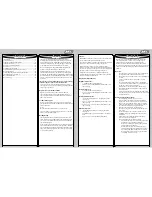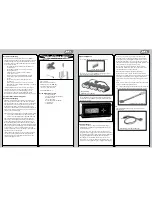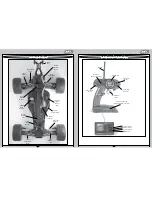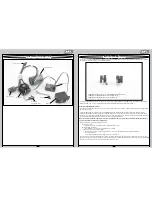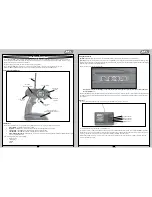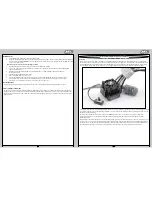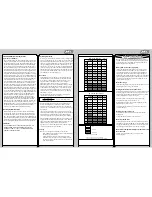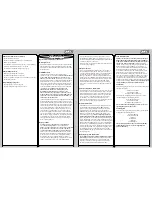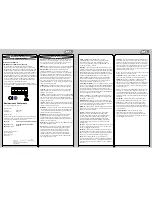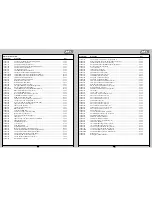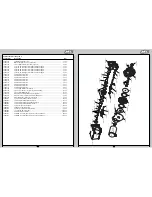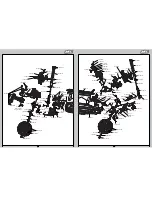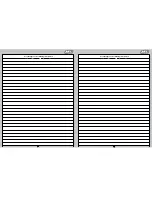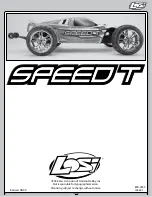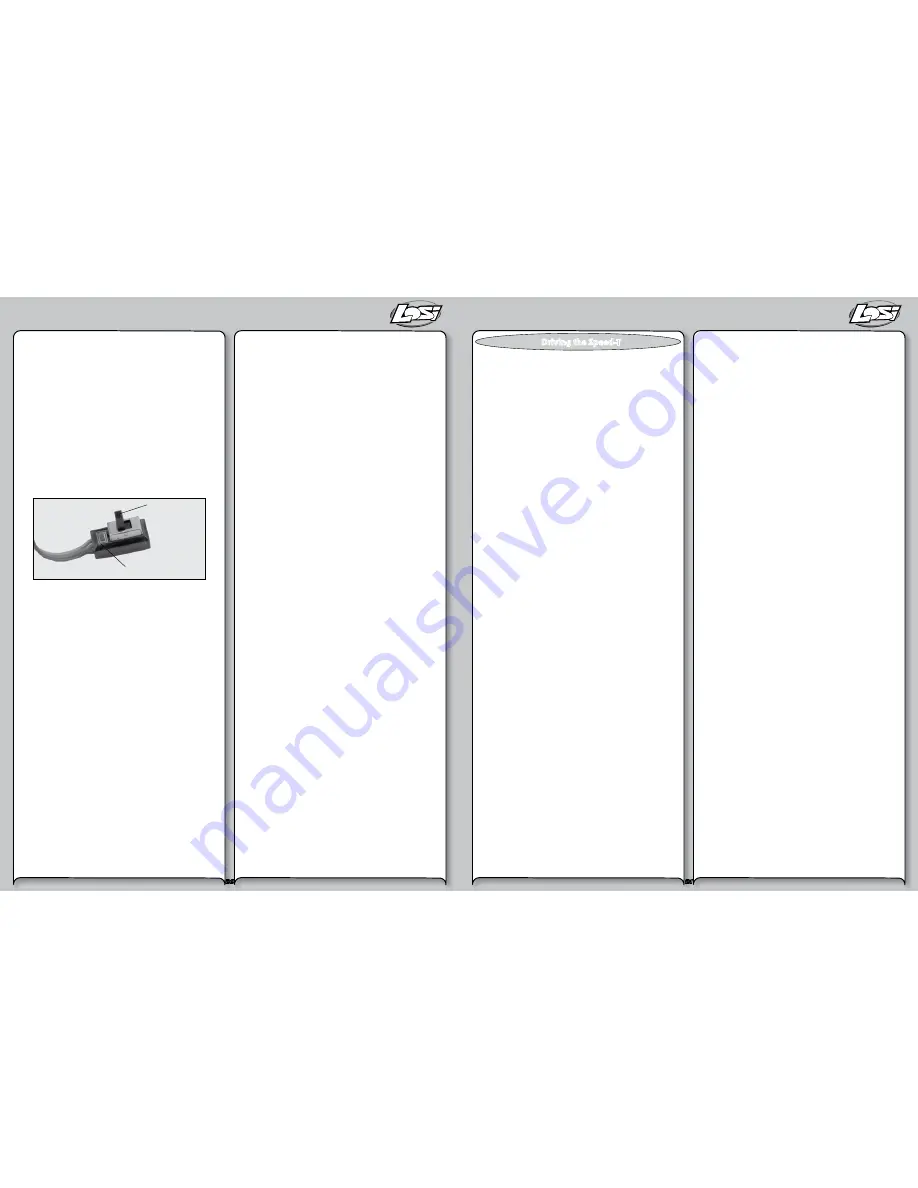
20
21
®
®
ESC Warning LEDs:
•
If the Battery low voltage cutoff (LVC) is reached the
Red LED will blink.
•
The Red LED will automatically turn off should the
battery voltage recover above the Low Voltage
Cutoff chosen.
•
If the ESC has detected a thermal overload the Yellow LED
will blink. Let the ESC to cool down.
Setup / Calibration to Transmitter
To perform the setup/calibration between the ESC and
Transmitter follow these steps:
1.
Turn on the transmitter.
2.
While turning on the vehicle Press and Hold the
setup button, notice the Yellow LED is now ON
solid. When the Yellow LED is on solid you can
release the setup button.
3.
Using the throttle trigger pull Full Throttle until the
Green LED is ON solid.
4.
Next push the throttle trigger to Full Brake until the
Red LED is ON solid.
5.
Now return the throttle trigger to the Neutral position
and the Blue LED is ON solid.
6.
Turn off the vehicle/ESC power switch.
7.
Turn the vehicle/ESC back ON; you are now ready to
use the ESC.
Normal Operation:
•
After turning on the vehicle, the Blue LED will be on for
normal operation.
•
If reverse is active then you will notice the Yellow LED
is also on.
Confirmation of Full Throttle and Brake:
•
While the ESC is on and operational if you pull the throttle
trigger to Full Throttle the Green LED will turn ON Solid.
•
Push the throttle trigger to Full Brake, the red LED will turn
ON solid.
Note: If the brake endpoint adjustment is reduced
after calibration then the Red LED will not turn on.
ESC – reverse operation
Should you get into a situation that requires reverse, after you
have applied any brakes you may have needed, return the
throttle trigger to the neutral position. Wait a moment or two
and then push the trigger forward for reverse.
Note: There is automatic protection within the
Xcelorin ESC. Only after you have stopped and
returned the trigger to neutral will reverse become
available. If you are in reverse you will notice a
delay if while travelling in reverse you pull the trigger
to go forward. This is to help prevent serious damage
to the drivetrain.
Please note the following precautions before running
your Speed-T.
•
The Electronics in this vehicle are not waterproof and you
must avoid running the vehicle in or through standing
water, wet grass, mud or snow.
•
This vehicle is very fast:
o Do not run the vehicle at dusk or in the dark of night.
o Do not run the vehicle if it will be out of sight for any
amount of time.
o Do not drive your vehicle near a crowd of people.
•
Perform a check of the vehicle before going out to run it.
o Ensure the tires are not coming off the rims.
o Generally check the vehicle for items such as a
loose wheel nut, or anything loose on the steering
assembly. The vibrations of running at high speeds
tend to loosen screws and nuts.
•
The Speed-T’s gearing choice from the factory IS NOT
meant for running the vehicle Off-Road and especially not
in grass.
•
Be careful driving when the battery is nearly discharged or
the car is running slowly. You could lose enough power for
the receiver to shutdown and you may lose control.
•
When driving the Speed-T be cautious and use common
sense. The speed of this RC vehicle may surprise
bystanders who could be injured if you accidently hit
them.
•
If your vehicle gets caught or stuck do not pull the throttle
in either forward or reverse. This will overload the ESC and/
or motor resulting in damage to one or possibly both and
is not covered by your warranty.
•
After running a battery pack, allow the electronics several
minutes to cool, before running the next battery pack.
•
When you are running and the batteries are low on
charge the ESC reduces the power to the motor. When this
happens the batteries are very discharged and continued
running may possibly damage your battery. If you are
using LiPo batteries when power to the motor is reduced
immediately stop running the vehicle. Over discharging of
LiPo batteries can be dangerous.
Run time consideration for the Speed-T vehicle.
The single largest factor in run time is the capacity mAh of your
battery pack. The larger the mAh rating the more run time you
will experience.
For example: if you have a 4600mAh battery pack you can
expect close to twice the run time of a 2000mAh battery pack.
The condition of a battery pack is also an important factor in
both run time and speed. As batteries see more use they will
degrade in performance and capacity.
How you drive your Speed-T will also affect your run times. If
you are performing runs, going from a standstill to full speed
repeatedly, you are asking a lot from your batteries. Hard
acceleration draws a lot of current from any battery and will
lead to shortened run time.
Note: Higher mAh rated battery packs will provide
power longer during heavy acceleration and long full
throttle runs.
If the bearings are dirty they will cause significant drag causing
reduced run times and speed.
To improve run times consider the following:
•
Keep your vehicle clean and maintained.
•
Allow more airflow to the heat sink of the Xcelorin ESC.
•
Change the gearing to a lower ratio, this will make the
electronics run cooler. This can be accomplished by using
a smaller pinion gear, or a larger spur gear than those
originally supplied. (The Speed-T comes with a 20-tooth
pinion and an 88-tooth spur gear.)
•
Change to battery packs of higher mAh rating.
•
Is the charger your using the best at charging your
batteries? Check with your local hobby dealer.
Driving the Speed-T
On/Off Switch
Setup Button


